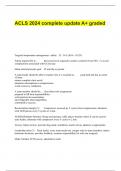Other
ACLS 2024 complete update A+ graded.
- Course
- Institution
ACLS 2024 complete update A+ graded Targeted temperature management - adults. 32 - 36 C (89.6 - 95.2F). Titrate inspired O2 to... the lowest level required to achieve arterial O2 sat 94% + to avoid complications associated with O2 toxicity. Mean arterial pressure goal ...
[Show more]



